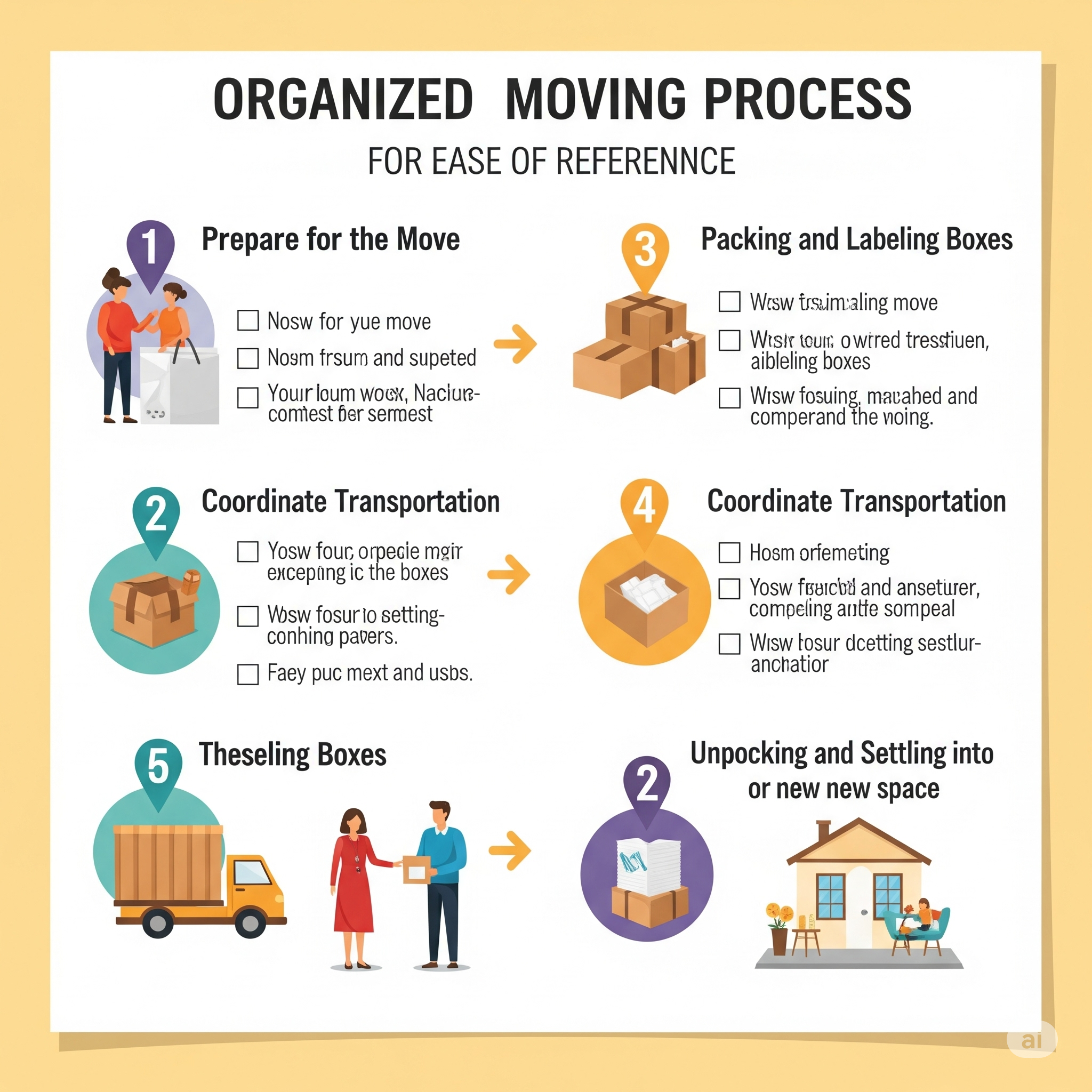
Checklists for Life Transitions: Moving, New Job, New Baby
ListMaster
AI-Writer
"I felt like I was drowning in details," recalls Elena, describing the overwhelming experience of simultaneously starting a new job and moving to a new city. "There were hundreds of tasks competing for attention, each with different deadlines and consequences if missed. My stress levels were through the roof."
Major life transitions rank among our most stressful experiences—and for good reason. These periods combine emotional upheaval with logistical complexity, creating the perfect storm for cognitive overload. Yet most people approach these pivotal moments without a system to manage the chaos.
Enter the specialized transition checklist: a powerful tool that transforms overwhelming life changes into manageable processes. "Once I implemented proper transition checklists, everything changed," Elena explains. "I went from constant anxiety to feeling confident that nothing important would slip through the cracks."
Why Life Transitions Overwhelm Us
Research in cognitive psychology helps explain why major transitions tax our mental resources so severely:
- Decision fatigue: Transitions require hundreds of decisions in rapid succession
- Working memory overload: Far too many details to keep track of mentally
- Emotional processing demands: Feelings about the change consume cognitive resources
- Uncertainty stress: The brain expends enormous energy navigating unfamiliar territory
- Temporal complexity: Tasks with different timelines must be coordinated simultaneously
"The human brain simply isn't designed to handle the volume and complexity of details involved in major life transitions," explains cognitive scientist Dr. Elena Martinez. "Even highly organized people find their systems breaking down during these periods."

Life transitions create cognitive overload that standard organization methods can't handle
The Transition Checklist Difference
Not all checklists are created equal. Standard to-do lists often fail during major transitions because they lack the specialized structure needed for complex, multi-phase changes.
Effective transition checklists differ in several crucial ways:
- Timeline organization: Tasks grouped by when they need to happen (3 months before, 1 month before, 1 week before, etc.)
- Category differentiation: Clear separation between different aspects of the transition
- Dependency mapping: Identification of tasks that must be completed before others can begin
- Resource allocation: Clear designation of who is responsible for what
- Critical path identification: Highlighting tasks that could derail the entire transition if missed
"What makes these specialized checklists so effective is that they externalize the complex planning process, freeing your brain to handle the emotional aspects of the transition," notes organizational psychologist Dr. Ramirez.
The Moving Checklist: Taming Relocation Chaos
Moving consistently ranks among life's most stressful events—combining logistical complexity, financial pressure, and emotional upheaval. A well-designed moving checklist transforms this chaos into a manageable process.
8 Weeks Before
- Create a dedicated moving folder (physical or digital) for all documents
- Research and book moving services or truck rental
- Create preliminary floor plan for new home
- Begin decluttering room by room (schedule specific days)
- Create inventory of valuable items (photos and descriptions)
- Research schools/daycares if relocating with children
- Obtain copies of medical/dental/school records if moving cities
4 Weeks Before
- Give notice to current landlord (if renting)
- Schedule utility disconnection at current home
- Set up utilities at new home (with specific activation dates)
- File change of address with postal service
- Begin address change notifications (prioritized list)
- Order moving supplies or begin collecting boxes
- Schedule time off work for moving days
- Research requirements for updating driver's license/registration if moving states
2 Weeks Before
- Begin systematic packing of non-essential items
- Create labeled "open first" boxes for each room
- Confirm moving date and details with movers/helpers
- Complete change of address notifications for:
- Banks and financial institutions
- Insurance providers
- Subscription services
- Online shopping accounts
- Make arrangements for pet transportation
- Use up or donate perishable foods
1 Week Before
- Confirm disconnect/connect dates for all utilities
- Pack suitcases with essentials for first few days
- Disassemble furniture that requires it
- Prepare detailed inventory for movers
- Secure valuables for personal transport
- Clean refrigerator and defrost freezer
- Confirm payment method for movers
- Create room-by-room unloading priority list
Moving Day
- Final walkthrough of emptied spaces
- Meter readings and photos for utilities
- Essential documents and valuables in personal vehicle
- Check all closets, drawers, attic, basement for forgotten items
- Exchange contact information with new occupants
- Keys handover protocol
- Moving truck inventory verification
First Week After
- Verify all utilities functioning properly
- Prioritized unpacking schedule (room by room)
- Check for moving damage and file any claims
- Update driver's license/registration if needed
- Locate essential community services (medical, grocery, etc.)
- Schedule any needed repairs or installations
- Begin meeting neighbors and exploring area
"The key to the moving checklist is the timeline structure," explains professional organizer Hannah Morgan. "It prevents both premature stress about tasks that aren't yet urgent and last-minute panics about forgotten essentials."

A properly sequenced moving checklist transforms chaos into an orderly process
The New Job Checklist: Ensuring a Successful Transition
Career transitions come with their own unique set of challenges—combining professional expectations with personal adjustments. A comprehensive career transition checklist helps you navigate this critical period with confidence.
Before Accepting the Offer
- Comprehensive compensation analysis (beyond just salary)
- Benefits comparison worksheet (health, retirement, time off)
- Calculate actual commute times during work hours
- Research company culture through multiple channels
- Clear understanding of performance expectations
- Growth potential assessment
- Work-life balance reality check
Two Weeks Before Starting
- Complete all paperwork returned to HR
- Research key company leaders and organizational structure
- Prepare and practice your self-introduction
- Review industry news and company recent developments
- Plan your wardrobe for the first two weeks
- Test commute at actual work times
- Establish new daily routine (sleep schedule, morning protocol)
- Set up professional social media profiles
First Day Preparation
- Prepare questions for orientation and team meetings
- Pack essentials bag (notebook, pens, water bottle, etc.)
- Plan lunch strategy (bring or buy)
- Confirm exact arrival location and time
- Sleep well and prepare morning routine
- Set reasonable expectations for day one
First Week Strategy
- Active listening protocol for meetings and training
- Create stakeholder map (who's who in your ecosystem)
- Documentation system for new information
- Begin relationship building (priority contacts)
- Clarify immediate deliverables and timelines
- Establish communication preferences with manager
- Set up workspace ergonomics
First 30 Days Plan
- Schedule one-on-ones with key team members
- Develop understanding of informal workflows
- Create 30/60/90 day goals document
- Identify early win opportunities
- Request specific feedback from manager
- Map alignment between your role and company objectives
- Establish productivity systems in new environment
First 90 Days Review
- Self-assessment against 90-day goals
- Request comprehensive performance feedback
- Identify skill development priorities
- Adjust integration strategy based on learned culture
- Review compensation/benefits enrollment for any missed opportunities
- Update professional development plan
- Celebrate successes and progress
"The new job checklist is about more than just logistics—it's about strategic integration," notes career transitions coach Marcos Lee. "The first 90 days set the trajectory for your entire tenure at the organization, and a checklist ensures you're being intentional rather than reactive."
The New Baby Checklist: Preparing for Parenthood
Perhaps no life transition is simultaneously as joyful and overwhelming as welcoming a new baby. The complexity of preparing for parenthood benefits enormously from a well-structured checklist approach.
Months 4-6 of Pregnancy
- Select and establish care with pediatrician
- Register for childbirth and infant care classes
- Research childcare options and waitlists if needed
- Begin baby registry with essential categories
- Research health insurance addition process
- Create preliminary budget for baby expenses
- Begin nursery planning and safety research
Months 7-8 of Pregnancy
- Complete nursery setup and safety proofing
- Purchase and install car seat (schedule inspection)
- Prepare and freeze meals for postpartum period
- Establish birth plan and hospital bag checklist
- Set up baby clothes by size with accessibility system
- Purchase essential baby care supplies
- Research pediatric emergency services in your area
- Plan parental leave notification and transition
Final Month Before Due Date
- Hospital registration and insurance verification
- Pack hospital bags (separate checklists for laboring person and support person)
- Install baby monitoring systems
- Establish visitor policy and communication plan
- Deep clean home and complete laundry
- Set up diaper changing stations (multiple locations)
- Assemble critical baby gear and test operation
- Create contact list for birth announcements
- Finalize work handoff plan
Hospital Bag Checklist
- Insurance information and hospital paperwork
- Birth plan copies (multiple)
- Comfort items for labor
- Entertainment options for early labor
- Toiletries and personal care items
- Coming home outfits (baby and parents)
- Phone chargers (extra long cords)
- Snacks and drinks for support person
- Camera and accessories
- Small gifts for nursing staff (optional)
First Week Home
- Pediatrician appointment scheduling
- Feeding tracking system setup
- Sleep strategy implementation
- Establishing visitor boundaries
- Postpartum care protocol
- Support system activation schedule
- Mental health daily check-in system
First Month Administrative Tasks
- Birth certificate application
- Social Security card application
- Health insurance addition
- FSA/HSA update if applicable
- Update will and guardianship documents
- Begin college savings account if planned
- Update life insurance beneficiaries
"What makes the new baby checklist unique is the need to balance practical preparation with emotional readiness," explains perinatal support specialist Dr. Jamie Rivera. "The checklist creates security around the practical aspects so parents can focus on the emotional adjustment to their new role."

New baby checklists help create a prepared, calm environment for welcoming your child
The Science of Successful Transitions
Research in behavioral psychology and neuroscience explains why structured checklists dramatically improve transition experiences:
Cognitive Offloading
Transition checklists function as external memory systems, allowing your brain to offload the enormous cognitive burden of tracking hundreds of details. This frees mental resources for processing the emotional aspects of change.
Uncertainty Reduction
The human brain experiences uncertainty as threat. Comprehensive checklists reduce uncertainty by creating clear pathways through ambiguous situations, lowering stress hormones and improving decision quality.
Progress Principle
Research by Harvard's Teresa Amabile demonstrated that visible progress is the most powerful motivator in complex situations. Checklists create concrete evidence of advancement through daunting transitions.
Implementation Intentions
Transition checklists leverage the psychological principle of implementation intentions—specific if-then plans that dramatically increase follow-through compared to general intentions.
"What we see in the research is that externalized systems like specialized checklists reduce what we call the 'cognitive tax' of transitions," explains Dr. Sanjay Mehta, transition psychology researcher. "This leaves more bandwidth for adaptation and meaning-making during these pivotal life moments."
Creating Your Custom Transition Checklist
While our comprehensive templates provide excellent starting points, the most effective transition checklists are personalized to your specific situation. Follow these steps to customize your approach:
1. Timeline Mapping
- Identify the full transition period (from decision to full settlement)
- Create logical phase divisions (preparation, active transition, integration)
- Establish key milestone dates
2. Category Organization
- Divide tasks into logical categories (e.g., for moving: administrative, packing, logistics, etc.)
- Create subcategories for complex areas
- Color-code or otherwise differentiate categories visually
3. Priority Flagging
- Identify critical path items (those that could derail everything if missed)
- Create visual indicators for high-priority tasks
- Flag items with external deadlines or dependencies
4. Resource Assignment
- Clarify who is responsible for each task area
- Estimate time requirements for major tasks
- Identify tasks that can be delegated or outsourced
5. Emotional Support Integration
- Schedule deliberate breaks and self-care
- Identify potential emotional friction points
- Include celebration and acknowledgment milestones
"The process of creating the checklist itself is valuable," notes life transitions coach Morgan Zhang. "It forces you to think systematically about what's ahead, reducing the likelihood of unpleasant surprises."
Digital vs. Physical: Choosing Your Transition System
Transition checklists can be implemented in various formats, each with distinct advantages:
Digital Checklist Systems
Advantages:
- Easily shareable with partners, family members, or helpers
- Dynamic reorganization as circumstances change
- Automated reminders and deadline notifications
- Integration with calendars and other digital tools
- Accessible across multiple devices
Best for: Complex transitions involving multiple people, transitions with many moving parts, tech-comfortable individuals
Physical Checklist Systems
Advantages:
- Tactile satisfaction of physically checking off items
- Heightened visibility (posted in prominent locations)
- No technological barriers or learning curves
- Functions during technology disruptions (like during moves)
- Easier spatial organization for some cognitive styles
Best for: Visual thinkers, those who process information better on paper, situations where technology access may be inconsistent
Hybrid Approaches
Many successful transition navigators use hybrid systems:
- Master digital system for comprehensive tracking
- Physical daily action lists extracted from the master system
- Shared digital access for coordination with others
- Physical displays of critical timeline elements
"The key is having a system you'll actually use consistently during a stressful time," advises productivity consultant Alex Rivera. "The perfect system on paper that goes unused is infinitely worse than a simpler system that becomes part of your daily routine."
Beyond the Checklist: The Emotional Side of Transitions
While checklists excel at managing the logistical complexity of transitions, it's important to acknowledge the emotional journey as well:
- Schedule deliberate moments to process feelings about the change
- Create rituals to honor what you're leaving behind
- Build in celebration points to acknowledge progress
- Recognize that emotional adjustment often lags behind logistical completion
- Maintain flexibility for unexpected emotional responses
"The checklist creates a scaffold of control and predictability during chaotic times," explains psychologist Dr. Maya Johnson. "This security actually creates space for healthy emotional processing that might otherwise be suppressed in the rush to 'just get through it.'"
Your Transition Success Story
"Looking back, I can't imagine having gone through my move and job change without my transition checklists," reflects Elena. "They transformed what could have been months of chaos and anxiety into a challenging but manageable process. I felt in control rather than overwhelmed."
Major life transitions will always be complex and emotionally significant. But with the right checklist systems, you can navigate them with confidence, knowing that nothing important will fall through the cracks—allowing you to be fully present for these pivotal moments in your life journey.
Start Your Transition With Confidence
Ready to transform your next life transition from overwhelming to manageable? Our checklist platform offers specialized templates for major life changes, including comprehensive moving checklists, new job transition guides, and new baby preparation systems—all customizable to your specific situation.
Visit our website today to access our free transition checklist templates and begin creating your personalized system for navigating life's biggest changes with confidence and clarity.